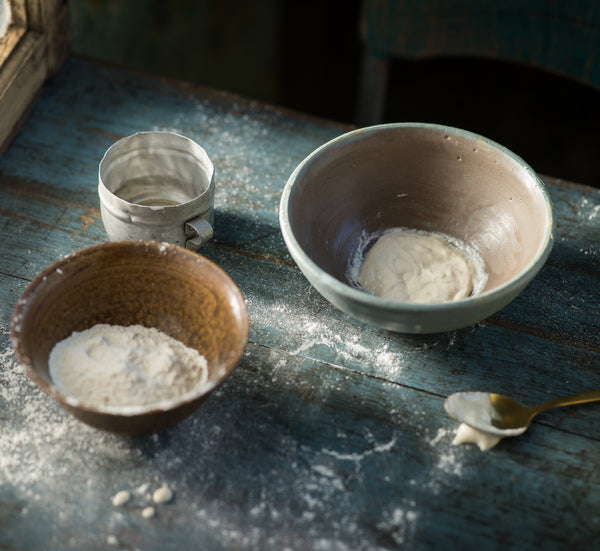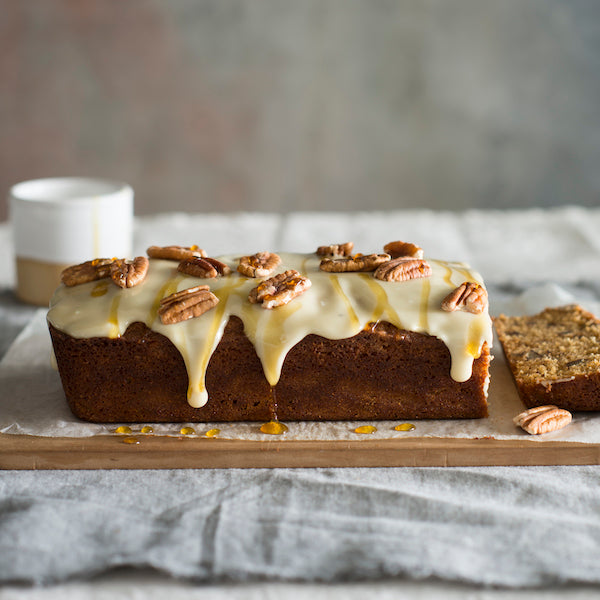BakeClub Blog

How to feed, maintain, store and use your sourdough starter
A practical, step-by-step guide with tips, tricks and timelines on how to make, feed, maintain and use your sourdough starter.
What is a sourdough starter?
Also known as a sourdough culture, a sourdough starter is a simple mixture of flour and water which acts as a natural leavening agent. Wild yeast is present in all flour and a starter is a way of cultivating it in a form that can be used to bake with. The characteristic sourness in a sourdough comes from the bacteria present that grow alongside the yeast in the starter and can range from very strong to quite subtle. As the sourdough starter matures the wild yeast and bacteria develop making it ‘stronger’ and more complex in flavour.
Only a small amount of sourdough starter is needed to make a batch of bread. Wild yeast works more slowly than commercial yeast so recipes made with a sourdough starter will typically take longer to make.
Making a sourdough starter is a simple process of combining flour and water, which is then subsequently ‘fed’ or refreshed with more flour and water over a period to encourage the yeast to ferment and the bacteria to develop.
Once established, a sourdough starter will go through a predictable cycle of bubbling, growing to about double its size, and then falling, and will take a similar time to complete this cycle if held at a consistent temperature.
What does ‘hydration’ mean?
Sourdough starters are often referred to as a percentage ‘hydration’, for example 100% hydration sourdough starter. The percentage indicates the hydration of the flour in the starter.
For example, a 100% hydration starter would be made from and fed with equal quantities (by weight) of both flour and water, or 1 part flour and 1 part water.
The hydration of a starter not only affects its consistency but also how quickly it will ferment. A less hydrated starter will be thicker and slower to ferment, hence requiring less feeding.
How to make your own sourdough starter
Click here for a practical, step-by-step guide on how to make your own sourdough starter.
If you would love to be guided through the process of making your own sourdough bread from making your starter through to baking your bread, click here to find out more about our online course BakeSchool: Sourdough.
Timeline for feeding your sourdough starter
Once you've read through the more detailed instructions below, here is a nifty quick reference to getting your sourdough starter strong and 'active' enough to use in baking:
125g starter + 125g flour + 125g water
↓ ↓
Stand until doubled in size (4—8 hours) → If not doubled in 8 hours, feed again every 12 hours until doubled in 8 hours or less
↓ ↓
Remove starter for recipe → use as directed
↓ ↓
Discard all but 125g remaining starter and feed with: 125g flour + 125g water
↓ ↓
Stand for 2-3 hours, then store in fridge → Feed once a week
OR
Store at room temp → Feed daily at same time
Feeding your sourdough starter
Once your sourdough starter is established, healthy and strong (and doubling in at least 8 hours when at room temperature), it will need to be ‘fed’ regularly to be kept active and to maintain its ‘strength’. If not fed regularly with fresh water and flour, the natural yeast within the starter will run out of food and ultimately die.
A mature and strong starter will have more flexibility and will be more resilient to changes than a young starter so don’t worry too much if you occasionally miss a feeding by a day or so or if your quantities are slightly out - just get back on track as soon as you can and your starter will bounce back.
To feed your sourdough starter, firstly use a clean utensil to remove all but 125 g of the sourdough starter from the jar. Then add 125 g plain flour and 125 g water and stir well until evenly combined. Seal the jar and store at room temperature or in the fridge.
Storing your sourdough starter
A sourdough starter can either be kept at room temperature or in the fridge.
If you aren’t intending to use your sourdough starter every day, it is best kept in the fridge. To do this, feed it as instructed above, seal the jar and then stand at room temperature for 2-3 hours (to help reinvigorate the yeast) before placing in the fridge to store.
A starter stored in the fridge will only require feeding once a week to maintain it.
If you use your sourdough starter every day, keep it at room temperature. Follow the feeding instructions above and then leave it at room temperature. You will need to ‘feed’ it every day (at the same time, if possible).
A sourdough starter stored at room temperature and fed everyday will have a milder flavour than one kept in the fridge and fed once a week.
Increasing the volume of your sourdough starter
If you want to increase the amount of sourdough starter you have, especially if you want to share it, you just need to ‘feed’ it with 125 g flour and 125 g water without first discarding any of the sourdough starter until you reach the desired quantity.
Freezing a sourdough starter
Sourdough starter can be frozen, if you would like to store it for a long period without feeding. To do this, double the amount of flour added at feeding so that it is a very thick paste, place in an airtight container and freeze for up to 1 year. Thaw at room temperature and feed as above to regain its strength before using.
Liquid on top?
If a grey-like liquid forms on top of your sourdough starter, this is an indication that an excess of alcohol has been produced as a by-product of the yeast fermentation. It often appears if the sourdough starter is ‘hungry’ because it has been left for longer periods of time without feeding or if it requires more frequent feeding.
If there is only a thin layer, you can either stir this liquid back into the sourdough starter or drain it away before feeding it again. If you stir it through, it will add a more intense flavour to your sourdough starter and, in turn, your sourdough bread.
If there is a thick layer, it is best to discard it before feeding.
Using your sourdough starter
When you want to use your sourdough starter in a recipe, feed it and stand at room temperature for 4-8 hours before you intend using it. It should at least double in volume and bubbles will start breaking the surface in this time, which will indicate that it is strong and ‘active’ enough to use. The time will vary depending on whether it has been stored in the fridge and the temperature at which it is standing. If it doesn’t, repeat the feeding and standing process until it does.
Remove the amount you require for the recipe and then repeat the feeding process and either stand at room temperature to use again or transfer to the fridge to store.
Once your starter is ready to use, this Basic sourdough bread recipe is a well-tested recipe to begin your sourdough baking.
This blog is part of Anneka's SBS Food Bakeproof: Sourdough online column. For more Bakeproof columns and recipes, click here.
Photography by Alan Benson.








